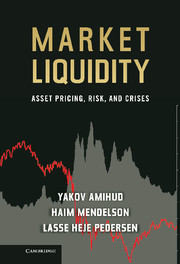Book contents
- Frontmatter
- Contents
- Acknowledgments
- Introduction and Overview of the Book
- Part I The Effect of Liquidity Costs on Securities Prices and Returns
- Part II Liquidity Risk
- Part III Liquidity Crises
- Introduction and Overview
- Chapter 6 Market Liquidity and Funding Liquidity
- Market Liquidity and Funding Liquidity*
- Chapter 7 Liquidity and the 1987 Stock Market Crash
- Chapter 8 Slow Moving Capital
- References for Introductions and Summaries
- Index
Introduction and Overview
Published online by Cambridge University Press: 05 December 2012
- Frontmatter
- Contents
- Acknowledgments
- Introduction and Overview of the Book
- Part I The Effect of Liquidity Costs on Securities Prices and Returns
- Part II Liquidity Risk
- Part III Liquidity Crises
- Introduction and Overview
- Chapter 6 Market Liquidity and Funding Liquidity
- Market Liquidity and Funding Liquidity*
- Chapter 7 Liquidity and the 1987 Stock Market Crash
- Chapter 8 Slow Moving Capital
- References for Introductions and Summaries
- Index
Summary
This chapter studies liquidity crises. A liquidity crisis is a situation where market liquidity drops dramatically as dealers widen bid–ask spreads, take the phone off the hook, or close down operations as their trading houses run out of cash and take their money off the table, security prices drop sharply, and volatility increases.
Brunnermeier and Pedersen (2009; Chapter 6 in this book) provide a theory explaining the origins and underlying dynamics that drive a liquidity crisis. It distinguishes between two kinds of liquidity: market liquidity and funding liquidity.
Market liquidity – the subject of much of this book – is the ease of trading a security. A security is liquid if the cost of trading it is low; for instance, it has a low bid–ask spread and a small market impact. Funding liquidity is a property of both securities and the agents that trade. A security has good funding liquidity if it is easy to borrow using the security as collateral. For instance, if a trader buys a security for $100, he may be able to borrow $80 with the security as collateral. The 20% of its value thatmust be financed with the trader’s own capital is called a margin requirement (or “haircut”). A 20% margin requirement means that a trader can leverage this security 5-to-1 while a higher margin requirementwouldmean that less leverage is available. A trader (e.g., a market maker, dealer, or hedge fund) has good funding liquidity if it has ample capital and access to financing with low margin requirements so it can take desirable positions with few constraints.
- Type
- Chapter
- Information
- Market LiquidityAsset Pricing, Risk, and Crises, pp. 185 - 195Publisher: Cambridge University PressPrint publication year: 2012
- 1
- Cited by

